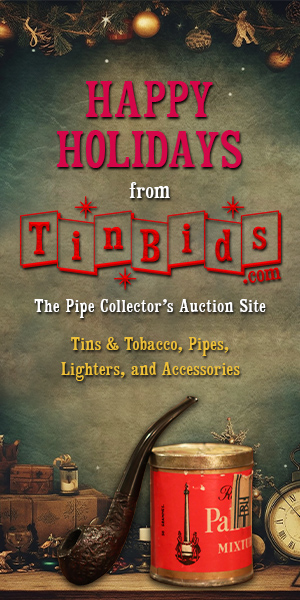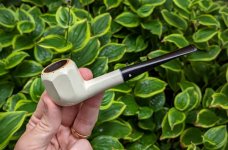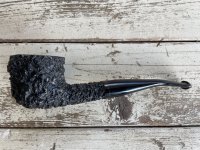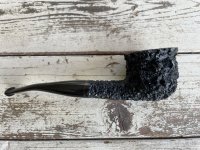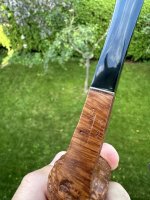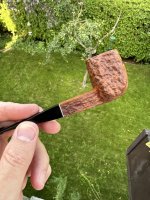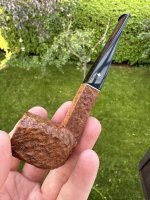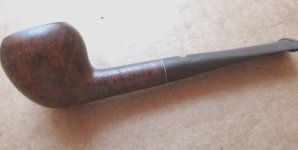Show Off Your Kaywoodie Pipes
- Thread starter crashthegrey
- Start date
You are using an out of date browser. It may not display this or other websites correctly.
You should upgrade or use an alternative browser.
You should upgrade or use an alternative browser.
SmokingPipes.com Updates
Watch for Updates Twice a Week
You saw the two I posted on page 16? I haven't smoked them yet, no idea on comparing to a Dunhill. Every Dunnie I have smoked has eventually left the herd. Shrug.I see those Kaywoodie Heritage pipes on Mkelaw. I’m curious if anyone here actually has one. The quality was supposed to be in competition with Dunhills of the time (60’s). I’m curious about them. Anyone?
Those look like beauties.You saw the two I posted on page 16? I haven't smoked them yet, no idea on comparing to a Dunhill. Every Dunnie I have smoked has eventually left the herd. Shrug.
I have one, a gift from a good friend and it’s a great smoker, I have two Dunhill Shells and I prefer the Heritage.View attachment 238226
My first Kaywoodie - An octagonal billiard in White Briar. She has some wear and patina, but I like it and she smokes well.
I just bought an Heirloom Heritage on eBay for 20$. I’ll put up a pic when I get it.I have one, a gift from a good friend and it’s a great smoker, I have two Dunhill Shells and I prefer the Heritage.
Close enough. Lol. Greywoodie Bramble rusticated by Allen Kipp, who actually did a lot of the Kaywoodie Thorn rustication, too.
I quite like those Greywoodies. The brambles are attractive and unique. Some day…
I've been collecting woodies for several years now. I collect the years from about 1928 to 1952 when 4 holes stopped. Haven't come across one like this. I know sils started in 43. And the engraving on 4 holes stopped about 41 with a transition from drinkless and the reg, to just drinkless and then by 42 nothing. The complete reg plus drinkless went until 1938 ish. I'm thinking this stem and bowl is a hybrid. But it aligns perfectly and the diameter of the stem shaft matches perfectly to the stummel. I'm not sure how a '43 sil could have a pre '39 stem on it. That's one hell of a restoration effort if it was. Either way its interesting story so I'm glad to have it in the collection. Any experts able to comment?
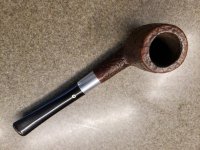
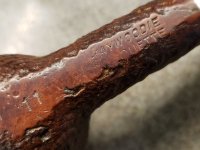
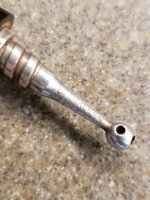



I've seen other mid 40's KWs with seemingly earlier stingers, they were just using up old stock. The war years were pretty chaotic for KW and you'll find stuff from 41-46 with all manner of contradictory fittings and stampings.I've been collecting woodies for several years now. I collect the years from about 1928 to 1952 when 4 holes stopped. Haven't come across one like this. I know sils started in 43. And the engraving on 4 holes stopped about 41 with a transition from drinkless and the reg, to just drinkless and then by 42 nothing. The complete reg plus drinkless went until 1938 ish. I'm thinking this stem and bowl is a hybrid. But it aligns perfectly and the diameter of the stem shaft matches perfectly to the stummel. I'm not sure how a '43 sil could have a pre '39 stem on it. That's one hell of a restoration effort if it was. Either way its interesting story so I'm glad to have it in the collection. Any experts able to comment?
View attachment 239996View attachment 239997View attachment 239999
That's awesome! As a collector I enjoy that it adds to the story of the pipe. It's the history.I've seen other mid 40's KWs with seemingly earlier stingers, they were just using up old stock. The war years were pretty chaotic for KW and you'll find stuff from 41-46 with all manner of contradictory fittings and stampings.
Some of those stems sat around after they were discontinued until they found the right bowl to put it on.I've been collecting woodies for several years now. I collect the years from about 1928 to 1952 when 4 holes stopped. Haven't come across one like this. I know sils started in 43. And the engraving on 4 holes stopped about 41 with a transition from drinkless and the reg, to just drinkless and then by 42 nothing. The complete reg plus drinkless went until 1938 ish. I'm thinking this stem and bowl is a hybrid. But it aligns perfectly and the diameter of the stem shaft matches perfectly to the stummel. I'm not sure how a '43 sil could have a pre '39 stem on it. That's one hell of a restoration effort if it was. Either way its interesting story so I'm glad to have it in the collection. Any experts able to comment?
View attachment 239996View attachment 239997View attachment 239999
Very nice! This all makes perfect sense. Thank you!Some of those stems sat around after they were discontinued until they found the right bowl to put it on.
That pipe is beautiful! I love my new age Rustica. It may very well be my favorite briar I own.I just started fixing up some estate pipes and this Kaywoodie Rustica turned out pretty good I think as my third project. Not quite sure on dating it, maybe you experts know.
They were only made from 1965 to 1967, until last year when I got Bill to make some new ones.I just started fixing up some estate pipes and this Kaywoodie Rustica turned out pretty good I think as my third project. Not quite sure on dating it, maybe you experts know.
Thanks for that-I might have to find me one as a “birth year” pipe (67)They were only made from 1965 to 1967, until last year when I got Bill to make some new ones.
I’m wondering if KBB in a clover leaf (Drinkless over Kaywoodie) on a Made in England pipe might signify that it’s an earlier pipe? I’m looking at pipes with ball of the stingers snipped off. But the patent number is there. And, who actually made the earliest English Kaywoodies and was the quality matching the U.S. operation?It's tough to know where to begin with this one. Kaywoodie and its related entities form a story fully as convoluted as the Cadogan analogue on the other side of the Atlantic. Worsening the tangle, Kaywoodie and Cadogan held interlocking interests in subsidiaries at one point to facilitate each of their export sales. To a large extent the Pipedia version is correct, as far as it goes, although details are sometimes seriously wrong. I've put off doing anything about it because of the complexity and multiplicity of people, companies, and events. I actually started a draft a dozen years ago but had to set it aside due to more pressing obligations (i.e. earning a living); it'll be a retirement project assuming I live that long. For now I'll make a few points and provide an extremely brief chronology. Hopefully this will provide a little incremental clarity.
First the prefatory remarks:
-it's almost impossible to make sense of this mess without know the individuals involved; each entity brought its own people into the mix, and in many cases they (or their children) played key roles
-think of an org chart of hideous complexity with shifting lines leading from one box to another, criss-crossing like cooked spaghetti dumped on the floor. To really understand what happened you need to create multiple parallel timelines showing when companies were created, merged, bought, and sold until you wind up with the SM Frank of today.
Here's a grossly simplified narrative. Each of these entities could easily be the subject of a chapter in a tediously long book:
-The oldest business is KB&B (1851), the key men were Leopold Kaufmann and Solomon Bondy, later joined by Leopold's brother Gottlieb Kaufmann
-Next came Reiss Bros & Co (c. 1886); the key men were brothers Julius and Otto Reiss (another brother named Nathan was in the tobacco leaf business), plus their sister Marie Reiss' husband Nathan Burger, and most importantly later on Marie's son Jacob (later Anglicized to John) David Burger; he played the pivotal role in the industry consolidation which happened a few decades later
-Next comes the Premier Briar Pipe Co (June 13, 1913), formed by Carl Hirsch (who immediately prior to this foray into pipemaking on a large scale had started another company which had gone bankrupt about the same time this venture was launched). Carl's nephew Rudolph Hirsch was to play an important leadership role in the combined businesses many years later
-Reiss-Premier Pipe Co was formed as the result of a merger between Reiss Bros and Premier Briar Pipe in 1920. The deal was orchestrated by John Burger (by this time his father and two uncles, the three original partners in Reiss Bros, were long dead) who ran the combined entity
-In August 1926 Reiss-Premier purchased a controlling interest in KB&B and operated it as "an associate company". Another "associate company" at that time was the Civic Premier Pipe Co, which was designated as the American representative of the UK's Civic Pipe Company, Ltd (the relationship between Cadogan and Reiss-Premier et al is worth a chapter of its own; this arrangement of course accounts for the appearance of the made-in-England Drinkless pipes appearing at this time). In the wake of the KB&B deal Reiss-Premier grew to 300 workers
-Five months before the crash of 1929, in April of that year, Burger negotiated a partial sale of Reiss-Premier to United Cigar Stores of America under David Schulte in the form of a stock swap. United Cigars purchased 49% of the company for equity in United Cigar valued at $735,000
-Meanwhile there is a parallel path involving the progress of Samuel Morris Frank (S. M. Frank & Co est. 1900) as he grew his business both organically and through acquisition. Two examples of the latter are the purchase of Manhattan Briar in 1922 from American Tobacco, and more significantly of Wm Demuth & Co bought from D. A. Schulte Inc (a subsidiary of the Schulte Retail Store Corp) in 1937. Here again the story is complicated but in brief Schulte had bought Demuth in the Spring of 1927. By the mid Thirties the Depression had taken a severe toll on Schulte's business and it was in financial distress. A legal reorganization that started in 1936 continued into 1937, in which year Schulte sold Demuth to S. M. Frank to raise some much needed cash
-After the acquisition Frank, driven at least in part by an impending loss of its own factory due to eminent domain, promptly consolidated its production into the Demuth Richmond Hill facility
-Meanwhile back at Reiss-Premier when John Burger died in 1944, Rudolph Hirsch wound up winning the succession contest to run the combined businesses
-Just six years later Associated Products, a Chicago manufacturer of deodorants, bought Reiss-Premier at the very end of 1950. The reasons for this are hazy to me; I suspect but can't prove it was yet another example of the unrelated diversification strategy which led to the creation of so many disparate conglomerates in the years after WW2 (e.g. ITT, GE, etc)
-Associated Products held the business for five years before selling it to S. M. Frank in 1955, which retains Reiss-Premier to this day
So there you have a light sketch of how the consolidation of most of the major American pipe manufacturers took place. I'll wrap up by making two smaller points. First, Kaywoodie as a brand dates to approximately March 1919. It was a deliberate renaming of the Dinwoodie, which itself dated from November 1916. Text from an ad to the trade dated March 1 1919: "In order to associate the name of the Dinwoodie pipe with the name of our house, it will hereafter be known as the Kaywoodie. Kay will serve to identify this superlative Italian Bruyere pipe with our name, KAUFMANN BROS. & BONDY." Second, why people refer to the Drinkless as a patent is unclear to me. While filed with the US Patent Office the actual grant (213598) is clearly for a trademark, i.e. the use of the word "Drinkless" in this context, not any internals to the pipe.
In reviewing the above I realize for those interested in Kaywoodie it is entirely to short, while for those who are not it must be a snooze fest of epic proportions. I apologize to both groups.





